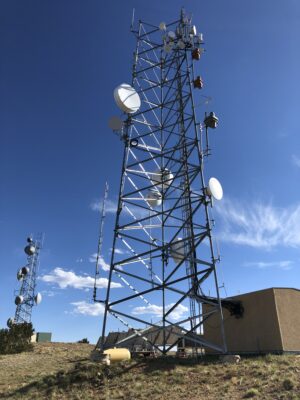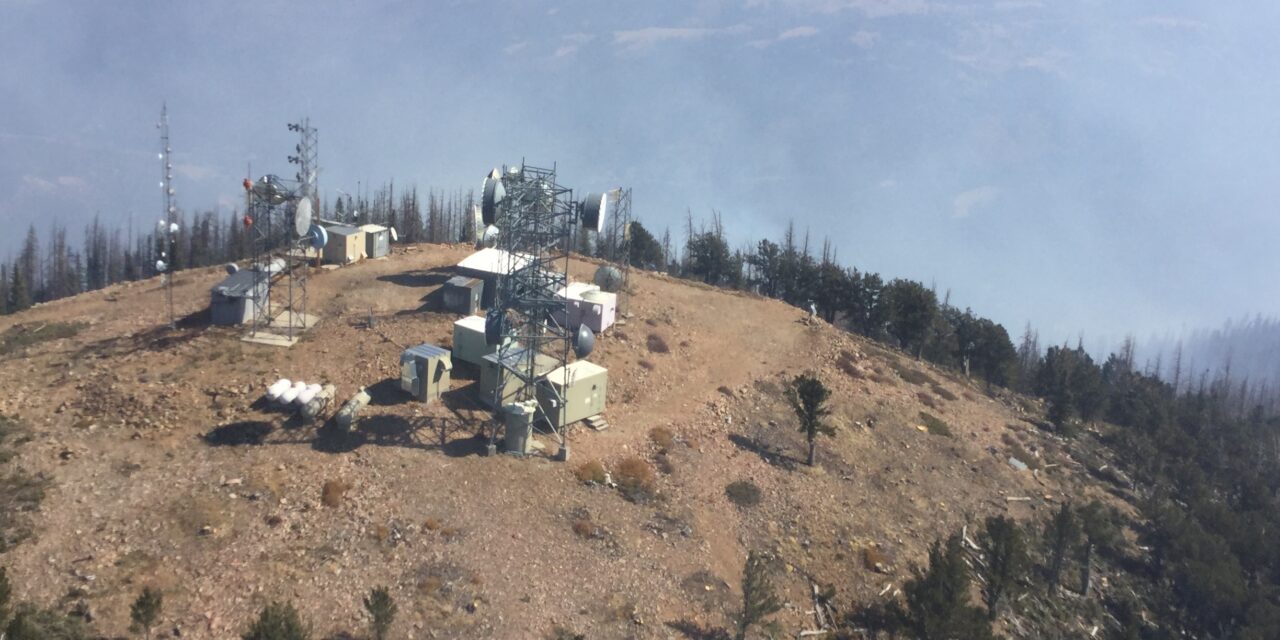Mark Young, the president of the Methodist Mountain Tower Users Group and CEO of Skytower, called Ark Valley Voice from the Houston Airport last Friday with good news for Chaffee County, the U.S.Forest Service (USFS), and indeed, for the entire southwestern United States.
“Everything’s done. It’s gone to Chaffee County Title and Escrow and the deed will be recorded this morning,” he said, the enthusiasm in his voice reaching across the line. “The tower users have secure access to the top – this isn’t a handshake agreement — this is a forever. It means we’ve now got clear access to the communications infrastructure at the top of Methodist for the first time. I can’t tell you what that means for public safety.”
‘This” is a legal agreement Young has pushed forward among the Methodist Mountain Tower Users group (representing more than 15 public safety infrastructure and communications entities that protect communications and utilities and a broad swath of the western U.S.), the recently-discovered other five owners of the Lost Charlie Ranch high up on the mountain and the USFS. For the past four years, the tower group and the USFS have been bedeviled by a family that claimed to be the sole owner of that land, who put up locked gates on CR 108, refusing them entry for safety and maintenance work and threatening those who attempted to use the access road.
But following AVV’s story about the public safety situation on top of the mountain, the other owners, all of whom were in Texas, and who had no idea this was occurring, came forward. Young lead the negotiations, working closely with Chaffee County and the Forest Service to resolve the situation.

In 2018 then Lt. Col. Mark young received a citation for his public service work as commander of Civil Air Patrol’s National Radar Analysis Team, presented by U.S. Rep. Scott R. Tipton, R-Colo., “for his 35 years of volunteerism in Colorado.”
The solution: Young personally negotiated a $300,000 deal to buy the land, renaming it the Rips Ranch (“I’m a big Yellowstone fan”) establishing an easement agreement with the U.S.F.S., redoing the gates with a tower access key that can’t be duplicated and seeing that all the legal paperwork was drawn up and the deed recorded.
He is modest about the way it happened. “We ended up determining that Tristate and certain agencies including the county would be able to do eminent domain, but we were going to have to go through federal court and sue them under eminent domain. All the state, county, and federal agencies were reluctant to do that, because it would be expensive, and could create a hostile situation,” he explained.
Asked about how the purchase price was determined, he takes a practical approach, saying he had to take out a mortgage to make it happen. “Well I came up with the money and it might be more than double what the property was worth, given the fact that the cabin burned down, and a large part of the property burned. That was double the assessed value. I never did get an appraisal … if you want a burned charred piece of land, it’s not worth much. But if it controls access to more than $3 million in equipment that provides critical public safety, then it’s worth a million.”
Young said the other five owners had owned it for 50 years, “but once they understood the situation, they were willing sellers and very nice people. So I got a 90-day agreement done in the interim so we could work out the details on the purchase. The only legal way that many of the agencies that were not governmental entities were going to be able to get legal access to the property, was for me to purchase the property.”

Towers on Methodist Mountain
He added that during that 90-days, the tower users were able to get their back up propane supply to the top and got their tower maintenance done for the winter.
Young was particularly complimentary about how cooperative Chaffee County was as he was working out the deal, noting that “a protracted lawsuit in federal court, regardless of who is going to win would cost millions. This way, we’ll finalize and deed the road easement to the county. By doing so it will make that a county road up to the south end of the property. This will provide access to the tower users to that point, all the way to the USFS land; from there they can go on to the top.”
Tracking down the owners, some of whom didn’t even know each other, was a detective job that Young says took hundreds of hours. If hearty, “can-do” men can be said to gush, Young did so about one of the owners, Walter Royse.
“I can’t say enough good about him. He’s retired after 40 years with Merrill Lynch. Walter took this on, head-on – he worked as hard on his end as I did on my end,” said Young. “Between the two of us, we were determined that we were going to get this done. Yes, there were attorneys fees, but it was a whole lot less than if we had a two-year court battle.”
He is also complimentary of his fellow Methodist Mountain Tower User Group members. “I asked them ‘nobody else sue — just let me negotiate this’ and they did. I applaud them all for sitting back and giving me the time to work this out – they were 100 percent there across the board.”
Young has one public caution that should be made very clear: this sale and the county road easement and agreement with the USFS does not mean this road or area are open for recreation. “The Forest Service road above that ranch on CR 108 has extremely dangerous conditions. There are a lot of burned snags – even in a vehicle, it is dangerous. We think the road is going to hold, but there are dangerous spots where it could flash flood and is closed to the public….it is posted ‘no Trespassing’ because it needs repairs.”
Young says that his all-volunteer efforts “have been the hardest project I’ve ever worked on, but reaching this agreement was vital to national security. That’s not an overstatement. It is public safety for about 15 states that travels through that mountain.” He paused and chuckled.” Jim Pitts (now USFS Regional Manager) told me I’d have been better off on a Six-Flags roller coaster. But this way it didn’t take two years in federal court or cost the county a half-million dollars.”







Thank you, all involved! I did t know this was an issue, but yes, we all rely on access to that mountaintop. Wonderful news!